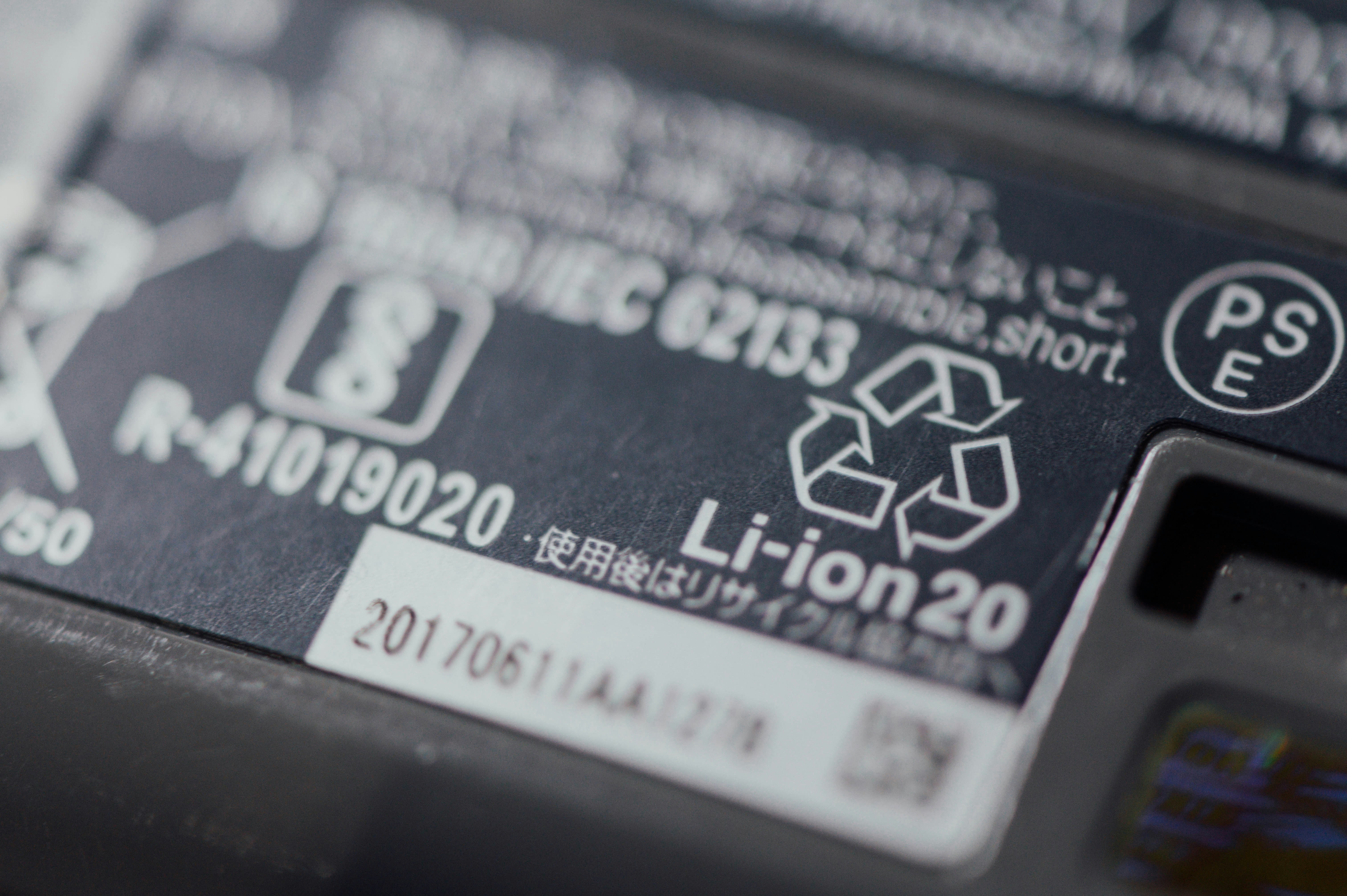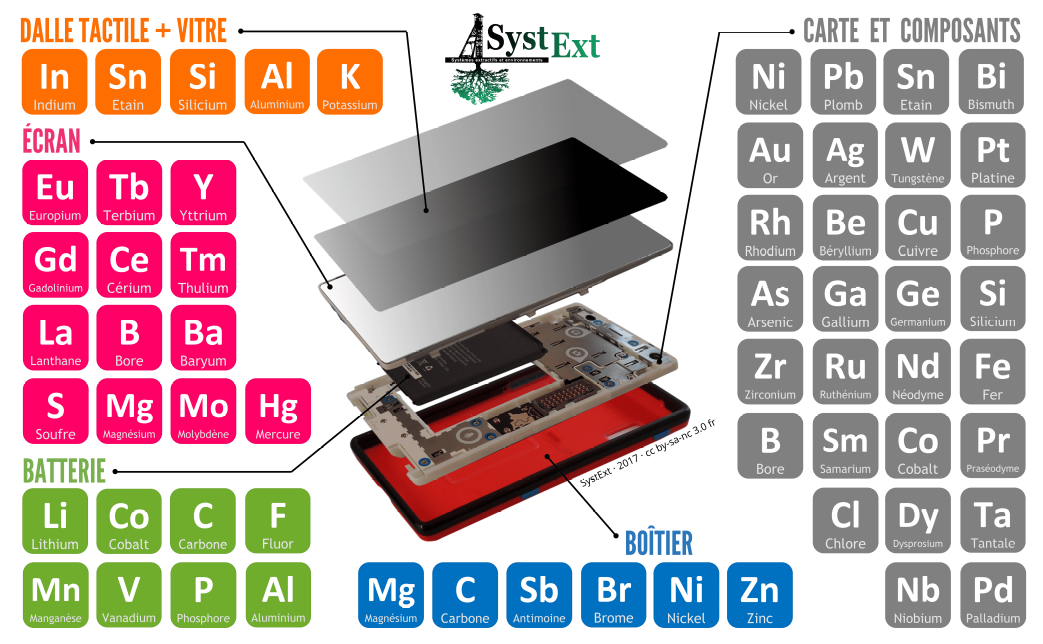Posted on
December 20th 2024
Tags
Metal recycling: the antidote to shortages?

Metals : the essentials of digital technology
Metals are a central component of digital technologies. Yet, few of us know the composition of the devices we use daily. We often know that copper is used for electric cables, or that lithium is used in batteries, and some of us even know that there are precious metals, such as gold or silver, in our smartphones. However, the list of elements that make up our electronic devices doesn’t stop there : a study carried out by the SystExt association has revealed that an average smartphone is composed of 52 different elements(1) !

Digital technologies thus require a lot of abiotic resources for the manufacturing of our devices (laptops, smartphones, TVs, servers, routers, smartwatches…) and in particular a wide variety of metals.
An unsustainable exploitation
Metals used for the manufacturing of our electronic devices are, in most cases, extracted from mines. However, mining is not and cannot be sustainable because of :
- its devastating environmental and human impacts ;
- the limited quantities of metals on Earth.
Because, contrary to popular belief, some of the world's most powerful countries, such as the United States of America, Australia or Canada, are among the countries with the largest mining areas in the world(2). While some social issues, such as child labour, are fortunately less prevalent in these countries, environmental issues unfortunately remain, as they are intrinsically linked to mining activities. Indeed, turning rock into ore requires multiple processes that are both energy-intensive and chemically devastating. For example, 8 to 10 % of the global energy consumption is used to extract and refine metals(3). Moreover, the persistent pollutions of soil, air, and both groundwater and surface waters, along with deforestation, lead to the irreversible loss of entire ecosystems (with significant biodiversity loss) as well as poisoning of miners and local populations. Unfortunately, there is no such thing as a "clean mine", even in "developed" countries. It is because of its major environmental and social impacts that the mining industry is the world's leading sector in terms of socio-environmental conflicts and murder of environmental activists(4).
Moreover, it is important to understand that metals are non-renewable resources and that they are not present in unlimited quantities on Earth. In fact, the richest and most easily exploitable deposits are gradually being depleted, which suggests a risk of shortages in the short or long term.
The considerable potential of recycling
“Nothing is lost, nothing is created, everything is transformed” a phrase often attributed to Antoine-Laurent de Lavoisier ; and indeed, the metals we use for the manufacturing of our devices don’t disappear from the surface of the Earth (except for those we send to space 🛰️ 🚀). Then, the obvious solution to the shortages appears to be recycling : recovering the metals in our end-of-life devices to make new ones.
The recycling of WEEE, waste electrical and electronic equipment, which includes our digital devices, has great potential. When conducted in formal systems, metal recycling has significantly lower environmental impacts than the extraction of new raw materials(5). And the potential is particularly important given that we produce a huge amount of waste every year : in 2022, 62 millions tonnes of WEEE were generated worldwide(6). Quantities so large that the resources contained in this waste are sometimes referred to as urban mines. Furthermore, some waste contains higher concentrations of metals than those found in mines. For example, a 2016 study(7), revealed that there was more gold in 1 tonne of circuit board waste than in 1 tonne of gold ore !
In addition to limiting the environmental impacts of mining, recycling offers significant potential for the sovereignty of certain nations. In fact, the uneven distribution of mines between countries often leads to strategic dependencies. For example, it is estimated that 95 % of rare-earth elements are produced by China(3), resulting in a situation of dependence for other countries. Recycling metals could provide a certain level of raw material autonomy for countries that don’t have mines on their territory.
The challenges of recycling
Unfortunately, things aren’t as simple as they may seem and there are multiple challenges to recycling.
- First of all, it is important to note that only 22% of WEEE are collected and recycled through formal systems(6). It is therefore essential to increase the collection rate and limit illegal recycling, which is an environmental and social disaster. Additionally, when losses at the various stages of the recycling process are taken into account, studies have shown that even for common metals such as iron, copper or nickel, a unit of metal is only reused 2 or 3 times before it is lost(8).
- Furthermore, even if we managed to recycle 100 % of the metals contained in WEEE, it still wouldn’t be enough to meet global demand. For example, the total amount of WEEE produced in 2019 contained 25 Mt of copper, iron and aluminum, but 39 Mt of these metals were required that same year for the manufacturing of electrical and electronic equipments(9).
- Not all the waste sent to oficial recycling channels can be recycled, particularly because metals are intricately mixed within our devices, and this issue worsens every year due to the ongoing advances in miniaturisation. Moreover, when recycling is possible, it doesn’t always achieve sufficient levels of purity for the metals to be reused in our devices. This is called downcycling, as the recycled material has a lower quality and value than the initial material.
- Finally, even though recycling is far preferable to extracting new resources, from an environmental and social point of view, this activity is not neutral.
Recycling can therefore be part of the solution, and although we can’t recycle everything, any extraction that we can avoid helps to minimise our impacts. However, considering the limits of this solution, sobriety and increasing the lifespan of our equipement are the only viable options today for more sustainable digital technologies !
💡 Tip !
Do you plan to get rid of your old device that no longer works and buy a new one to replace it ? The seller is obligated to take back your old device, for free, directly in the store, or at your home in the case of delivery. Alternatively, the ecologic website lists official collection points.
(1) Tool available to explore the results at this link
(2) Maus, V., Giljum, S., da Silva, D. M., Gutschlhofer, J., da Rosa, R. P., Luckeneder, S., … & McCallum, I. (2022). An update on global mining land use. Scientific data, 9(1), 433.
(3) Géosciences, la revue du BRGM pour une Terre durable. Géosciences n°15 - Ressources minérales : Contribution au Sommet de la Terre 2012 | BRGM
(4) Scheidel, A., Del Bene, D., Liu, J., Navas, G., Mingorría, S., Demaria, F., … & Martínez-Alier, J. (2020). Environmental conflicts and defenders: A global overview. Global Environmental Change, 63, 102104.
(5) Hischier, R., Wäger, P., & Gauglhofer, J. (2005). Does WEEE recycling make sense from an environmental perspective?: The environmental impacts of the Swiss take-back and recycling systems for waste electrical and electronic equipment (WEEE). Environmental Impact Assessment Review, 25(5), 525-539.
(6) Cornelis P. Baldé, Ruediger Kuehr, Tales Yamamoto, Rosie McDonald, Elena D’Angelo, Shahana Althaf, Garam Bel, Otmar Deubzer, Elena Fernandez-Cubillo, Vanessa Forti, Vanessa Gray, Sunil Herat, Shunichi Honda, Giulia Iattoni, Deepali S. Khetriwal, Vittoria Luda di Cortemiglia, Yuliya Lobuntsova, Innocent Nnorom, Noémie Pralat, Michelle Wagner (2024). International Telecommunication Union (ITU) and United Nations Institute for Training and Research (UNITAR). 2024. Global E-waste Monitor 2024. Geneva/Bonn.
(7) Geldron, A. (2016) . Métaux stratégiques : la mine urbaine française. Annales des Mines - Responsabilité & environnement, N° 82(2), 67-73. https://doi.org/10.3917/re1.082.0067.
(8) Graedel, T. E., & Reck, B. K. (2014). Recycling in Context. Dans E. Worrell, & M. A. Reuter, Handbook of Recycling: State-of-the-art for Practitioners, Analysts, and Scientists (p.22). Elsevier.
(9) Forti V., Baldé C.P., Kuehr R., Bel G. The Global E-waste Monitor 2020: Quantities, flows and the circular economy potential. United Nations University (UNU)/United Nations Institute for Training and Research (UNITAR) – co-hosted SCYCLE Programme, International Telecommunication Union (ITU) & International Solid Waste Association (ISWA), Bonn/Geneva/Rotterdam.
©Photo Chuttersnap, Unsplash.
Other posts
Every post >Contact
Let's meet !
Thank you for reading our blog. If you wish to find out more, feel free to contact us.
Koevoo needs the contact details you provide to contact you about our products and services. You can unsubscribe from these communications at any time. See our Privacy Policy to learn more about how to unsubscribe, our privacy policies and our commitment to privacy.
